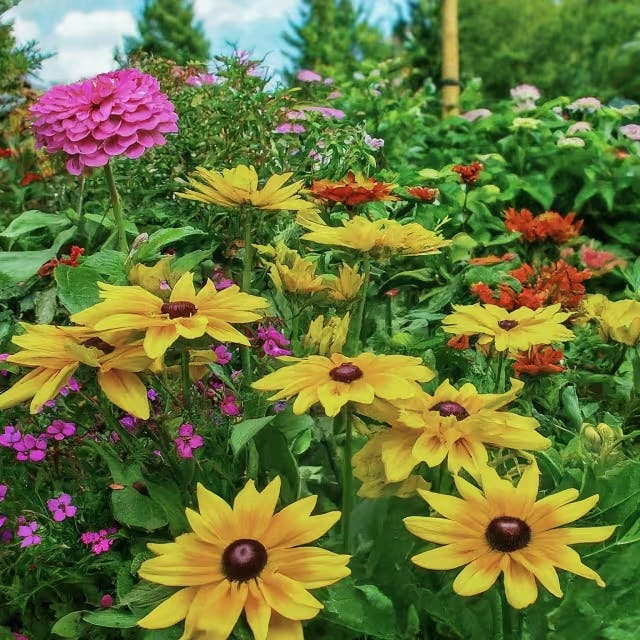Enjoying Your Garden in July: Tips and Ideas
Go4Turf
February 25, 2024

As the warmth of July blankets your garden, navigating the challenges and embracing the opportunities of the season is crucial to enjoying your outdoor space. Drawing on insights from Utah State University Extension's Gardener's Almanac, this article presents practical tips and fresh ideas for maximizing water usage, selecting July-friendly plants, and implementing essential garden maintenance to thrive in the summer heat. Whether you're harvesting ripe tomatoes, managing pests, or seeking the comfort of shade, discover how to make the most of your garden in July, ensuring it remains a place of beauty, productivity, and tranquility even during the hottest days.
Key Takeaways
Maximizing water usage is crucial for garden health in July, with strategies including early morning irrigation to reduce evaporation and using mulch to retain soil moisture recommended.
Select plants that are well-suited to the July heat, focusing on those that can thrive in higher temperatures and possibly withstand drought conditions.
Implement essential maintenance such as regular weeding, pest monitoring, and harvesting ripe produce promptly to keep your garden productive and healthy.
Consider creating shaded areas or incorporating shade-tolerant plants to protect your garden from the scorching sun and make outdoor spaces more comfortable.
Maximizing Water Usage for Garden Health in July
July's rising temperatures mean your garden requires careful water management. Early morning watering reduces evaporation, ensuring more water reaches your plants. Consider a drip irrigation system or soaker hoses for efficient, root-level watering, minimizing wastage and reducing leaf wetness that can lead to diseases. Mulching plays a crucial role, too; a 2-3 inch layer of organic mulch retains soil moisture and keeps roots cool. If you're unsure about when to water, a simple finger test—checking soil moisture a few inches deep—can guide you. For those looking to dive deeper into sustainable gardening practices, exploring techniques like recycled newspaper pots or learning more about effective seed starting can enhance your garden's health and your enjoyment of it this July.
Selecting July-Friendly Plants for Your Garden
When planning your garden for July, you'll want to pick plants that can handle the heat and still show off under the bright summer skies. Purple podded bush beans are a great choice, not just for their stunning color, but because they really thrive in warmer temperatures. If you're curious about how to grow these eye-catching beans, take a peek at this comprehensive guide on growing purple podded bush beans.
Also, think about adding golden snow peas to your mix. They're as tasty as they are nutritious, making them the perfect addition to your summer salads. Find out everything you need to know about cultivating golden snow peas right here and consider them for your July planting.
Don't forget about the herbs! Wild Zaatar Oregano not only endures the summer heat but also adds a fragrant touch to your garden and cooking. To get acquainted with its distinct flavor and growing tips, check out Wild Zaatar Oregano.
Lastly, incorporating African Blue Basil into your garden does more than just attract helpful pollinators. It also provides health benefits and a unique flavor that'll enhance your dishes. Learn all about the benefits and beauty of African Blue Basil to make your garden vibrant and sustainable this July.
Essential July Garden Maintenance Tips
Amidst the peak of summer, your garden requires attention to thrive. July's warmth calls for regular watering, ideally in the early hours, to ensure deep soil penetration and prevent evaporation. Checking your garden's hydration is crucial; a simple trick is to stick your finger into the soil. If it's dry an inch below the surface, it’s time to water.
Mowing plays a significant part in lawn care. Raising the mower's blade in summer protects grass roots from the scorching sun. Aim for a height of about 3 inches to keep your lawn resilient and healthy. Rutgers Cooperative Extension emphasizes the importance of selecting the right turfgrass and proper mowing techniques for an optimal lawn.
Pests and weeds don't take a break, so neither should your vigilance. Regularly inspect plants for signs of distress and manage invaders promptly to prevent them from taking over. For organic pest solutions, consider natural predators or barrier methods.
Fertilization doesn't stop in July. Choose a slow-release fertilizer that won't burn your plants in the summer heat. Remember, a little goes a long way during this season.
For those with a penchant for indoor seed starting, it’s a good time to plan for late summer and fall vegetables. Check out our guide on starting seeds indoors to get ahead.
Lastly, take time to enjoy your garden. Early morning or late afternoon is perfect for relaxing outdoors, avoiding the midday heat. Your garden is not just a space for chores but a sanctuary for peace and enjoyment during these long summer days.

Creating Shade and Comfort in Your Garden During July Heat
As the July sun beats down, transforming your garden into a sizzling retreat, creating pockets of shade can offer a much-needed oasis. Strategic placement of trees and shrubs can not only provide relief from the heat but also enhance the beauty of your outdoor space. Consider integrating plants that grow well in your area for the best results. A free web app, as noted by Theresa Badurek from the University of Florida/IFAS, can assist in selecting the right vegetation for your garden, ensuring that your choices are both beautiful and functional. For more detailed guidance on planting trees and shrubs effectively, explore available resources such as instructional videos and informative websites here.
Additionally, incorporating portable shade solutions like umbrellas or cloth canopies can quickly create comfortable spots for relaxation or dining. Remember, the goal is to make your garden an enjoyable place for all, even during the peak of summer's warmth. In conclusion, enjoying your garden in July requires mindful strategies such as efficient water use, selecting heat-resistant plants, and performing timely garden maintenance. By incorporating these tips and ideas, including creating shaded areas for comfort, your garden can thrive and become a tranquil oasis even in the heat of July. Implementing these practices not only enhances the health and beauty of your garden but also maximizes your enjoyment of the outdoor space during the summer months.
Frequently Asked Questions
How can early morning watering benefit my garden in July?
Early morning watering benefits your garden in July by ensuring more water reaches the plants due to reduced evaporation. Using efficient watering methods like drip irrigation targets the roots directly, minimizes waste, and helps prevent diseases by keeping foliage dry. Additionally, a layer of organic mulch retains soil moisture and keeps roots cool, enhancing overall plant health during the warm July weather.
What mulching techniques are best for retaining soil moisture during hot months?
To best retain soil moisture during hot months, employ a mulching technique that involves applying a 2-3 inch layer of organic mulch around your plants. This not only retains soil moisture but also keeps the roots cool, significantly reducing the need for frequent watering. Additionally, consider utilizing early morning watering strategies and investing in a drip irrigation system or soaker hoses for efficient water delivery directly to the plant roots, thereby minimizing water wastage and reducing leaf wetness that could lead to diseases.
What are the top plants to grow in July for a vibrant garden?
For a vibrant July garden, consider planting purple podded bush beans and golden snow peas, which thrive in warmer temperatures and enhance your summer salads. Wild Zaatar Oregano and African Blue Basil are perfect herbs to sustain the summer heat while adding flavor to your dishes and attracting pollinators. Remember to water your garden in the early morning to minimize evaporation and check soil moisture regularly for optimal hydration. Mulching and efficient watering systems are also key to maintaining a healthy, vibrant garden throughout July's warm conditions.
How does raising the mower blade height impact lawn health in summer?
Raising the mower blade height in summer to about 3 inches helps in protecting the grass roots against extreme heat and enhances lawn resilience. This adjustment ensures the taller grass can shade the ground beneath, maintaining soil moisture and keeping root systems cool. Following the correct mowing height as suggested, along with adopting effective watering strategies like early morning watering, can significantly contribute to a healthier, drought-resistant lawn during the harsh summer months.
What are effective organic pest control methods for garden care in July?
Effective organic pest control for your garden in July involves introducing natural predators such as ladybugs and praying mantises that feed on common pests. Employing barrier methods, like floating row covers, can protect your plants without the use of chemicals. Additionally, homemade sprays with ingredients like neem oil or a mixture of water and mild dish soap can offer a safe, natural deterrent to pests, ensuring your garden thrives through the summer heat.
How can I create pockets of shade in my garden to enjoy it more during the July heat?
Creating pockets of shade in your garden for July can be achieved through planting heat-tolerant trees and shrubs, utilizing portable shade options like umbrellas or cloth canopies, and strategically placing them for maximum comfort. Selecting the right vegetation is crucial; tools and resources provided by gardening experts, like those from the University of Florida/IFAS, can guide you in making effective choices for your area. This approach not only cools down your space but also adds to the aesthetic appeal of your garden.